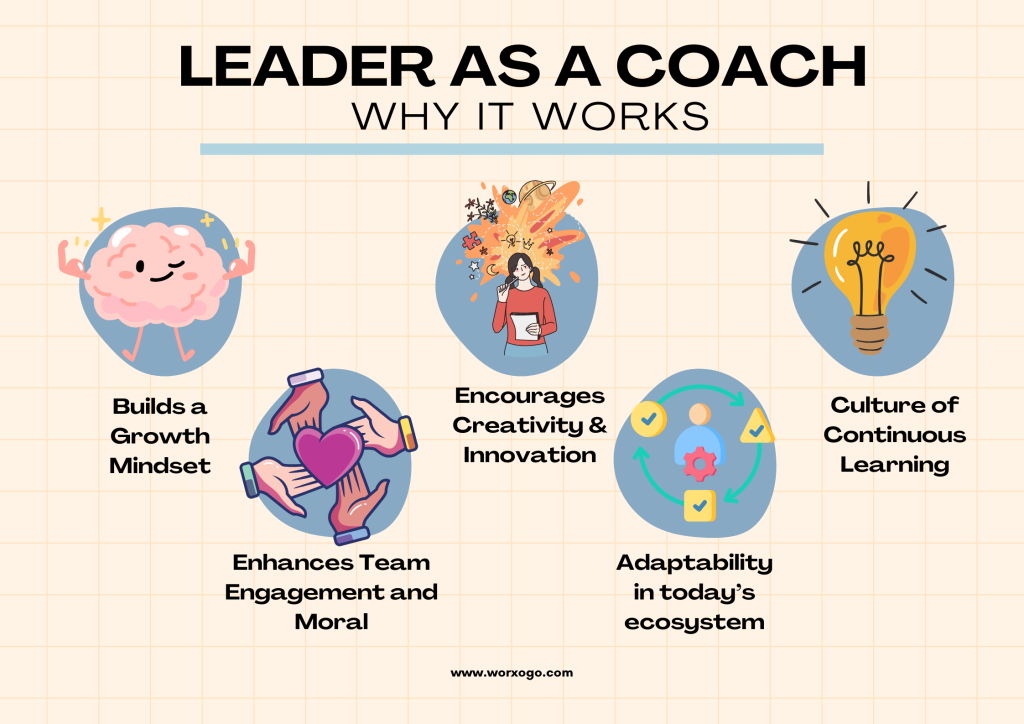Leadership has evolved over time, shifting from command-and-control approaches to more collaborative and people-centric models. Among these, the “Leader as a Coach” style has emerged as the most effective. This leadership approach focuses on guiding, mentoring, and empowering individuals rather than simply directing them. With the rapid advancement of artificial intelligence (AI) and AI tools, leaders can enhance their coaching capabilities like never before.
Why the ‘Leader as a Coach’ model works

1. Builds a Growth Mindset
Unlike traditional authoritarian leadership, coaching-oriented leaders encourage continuous learning and development. They don’t just issue orders; they ask questions like, “What do you think is the best solution?” or “How can we improve this process?” This fosters problem-solving.
2. It Enhances Team Engagement and Morale
People thrive when they feel valued and heard. Coaching leaders prioritize active listening, constructive feedback, and genuine encouragement. Employees under coaching leadership tend to be more engaged, productive, and satisfied with their work. A CEO who embraced the coaching leadership style once told his team, “I’m here to coach, not to micromanage. Think of me as your personal GPS—I’ll guide you, but I won’t grab the wheel.” A team member jokingly responded, “That’s great, but I hope you’re not like Apple Maps leading us into a lake!”
3. It Encourages Creativity and Innovation
By focusing on mentorship rather than directives, coaching leaders create an environment where new ideas can flourish. Team members feel safe experimenting and suggesting improvements, knowing they won’t be punished for making mistakes.
4. Adaptability in Today’s Ecosystem
In today’s rapidly changing business landscape, adaptability is key. The “Leader as a Coach” model is crucial because it fosters agility, resilience, and continuous learning within teams. Industries are evolving at an unprecedented pace due to digital transformation, remote work, and global competition. Coaching leaders help employees navigate change by guiding them rather than imposing rigid structures.
A coaching leader doesn’t just give orders; they empower their teams to take initiative and develop solutions independently. This approach leads to higher employee retention, as team members feel more invested in their roles and confident in their skills.
5. A Culture of Continuous Learning
The job market today requires constant upskilling. Coaching leaders emphasize learning and development, ensuring that employees stay ahead of industry trends. They promote a growth-oriented mindset, where failure is viewed as a learning opportunity rather than a setback.
How AI helps
AI is supporting leaders in adopting and excelling at the coaching leadership style.
1. AI-Powered Feedback and Performance Analysis
AI-driven platforms and even simple AI-driven analytics in Microsoft Teams can provide leaders with insights into employee performance. These tools analyze trends in productivity, communication patterns, and engagement levels, helping leaders provide personalized coaching. Imagine an AI tool that tells you, “Sarah has been excelling at creative problem-solving but struggles with meeting deadlines.” Instead of micromanaging, a coaching leader can use this data to mentor Sarah, helping her develop better time management strategies.

2. AI Chatbots as Virtual Mentors
AI-powered chatbots can act as 24/7 coaches for employees, answering questions, offering learning resources, and even conducting regular check-ins to track progress. An employee once asked an AI chatbot, “How do I ask for a raise?” The bot replied, “First, build your case with data. Second, highlight your contributions. Third, avoid saying, ‘Because rent is too high.’” AI: Keeping you professional, one response at a time!
3. AI-Enhanced Learning and Development
AI-driven platforms can leverage learning platforms and personalize training programs based on employees’ skills and goals. Coaching leaders can use AI to recommend courses and skill-building exercises that align with their team members’ career aspirations.
4. Sentiment Analysis for Better Emotional Intelligence
Some AI tools can analyze employee sentiment through surveys and feedback forms. A coaching leader can use this data to understand team morale and adjust leadership strategies accordingly. If sentiment analysis reveals that the team feels overwhelmed, a coaching leader might focus on delegation and workload management instead of pushing for faster results.
Conclusion
The “Leader as a Coach” style is all about empowering employees, fostering innovation, and creating a workplace where growth and collaboration thrive. AI and AI tools can significantly enhance this leadership approach by providing insights, automating administrative tasks, and even offering real-time coaching assistance. But at the end of the day, AI is just a tool. The real magic lies in how a leader uses it to inspire and uplift their team. So, the next time someone asks if AI will replace leaders, just remind them: “AI can be a great co-pilot, but it still takes a human leader to steer the ship (and crack the occasional bad joke).”
About the author
Sumit Gandhi has over 25 years of experience in the technology industry. His approach to using coaching as a leadership style has helped create multiple high growth organizations. As a Leadership & Business Coach, he has been working with senior executives to help them unlock their personal potential. Prior to this, Sumit was a CXO with a healthcare technology organization managing various global functions including service delivery, talent, operations, and cross functional transformations.



